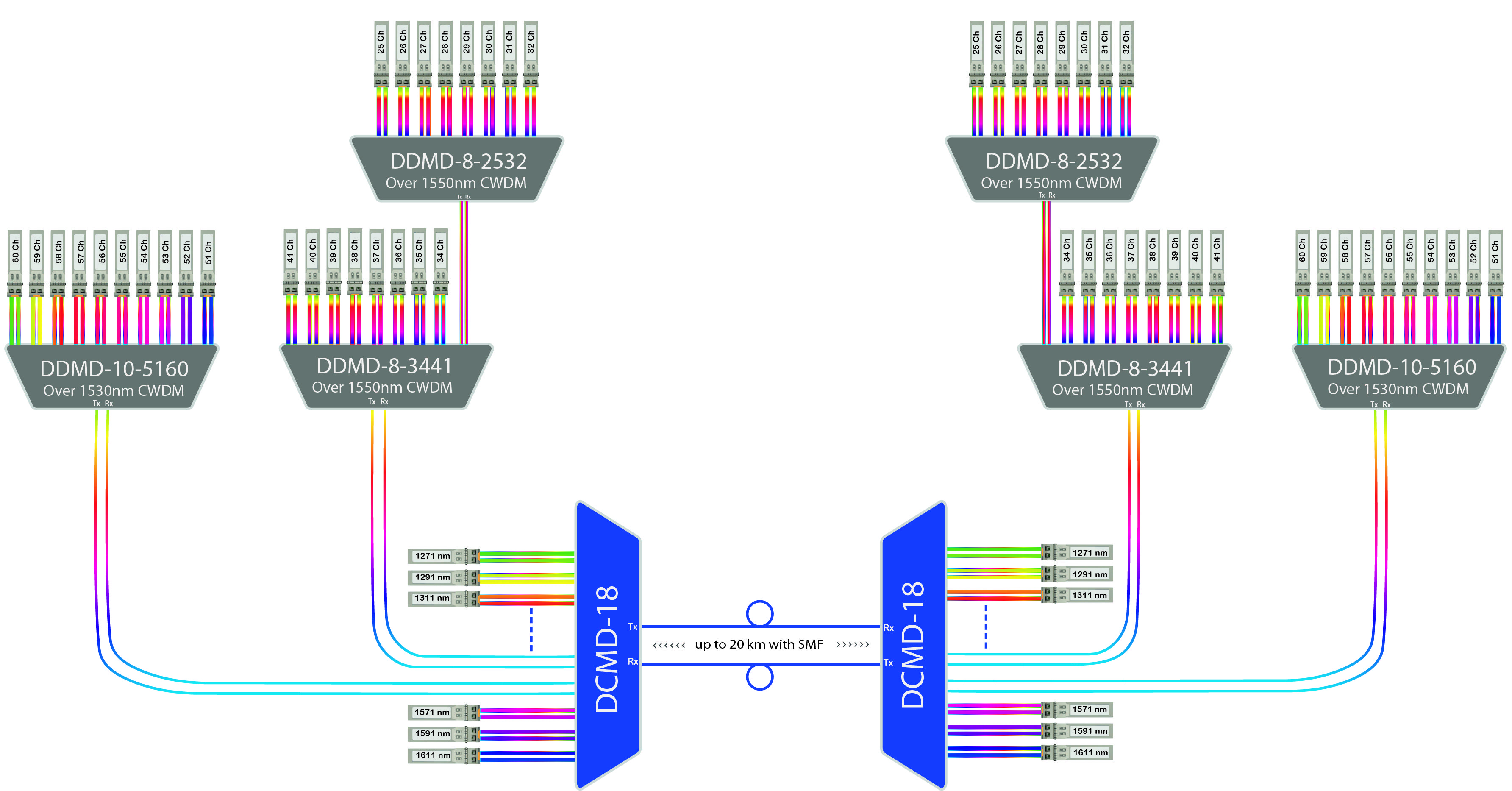CWDM & DWDM Hybrid system – Why and How?
CWDM and DWDM are seen as two separate multiplexing approaches, but it is well known that DWDM channels are overlapping CWDM channels thus making a new system DWDM over CWDM. This forms a potential for a hybrid system with CWDM and DWDM combined. We will take a deeper look into this DWDM over CWDM Hybrid-WDM solution and see what is possible with it, why it is needed and how to achieve it.
Firstly, let’s start with a brief introduction about CWDM and DWDM. CWDM stands for Coarse Wavelength Division Multiplexing and it is a technology defined by ITU-T G.694.2 that uses up to 18 channels to be simultaneously transmitted over a single fiber-optic cable. The technology uses channels in the range from 1270nm to 1610nm with 20 nm spacing between them. All 18 channels are divided in half into the two most popular regions: 1310 and 1550. Full list of CWDM channels can be seen in our CWDM Channel Plan article.
DWDM or Dense Wavelength Division Multiplexing is another xWDM technology, which allows for a greater data throughput thanks to the many channels for information transfer over two SMF (Single-Mode Fiber) lines (one for sending, the other for receiving). The channels are established according to ITU-T G.694.1 standard, which proposes possible channel spacings from 12.5 GHz to 100 GHz and more, and are split into various pre-defined “bands”. Nowadays, the common practice for DWDM are 100 GHz C-Band based systems, which uses DWDM channel plan with channels 17 to 61 with channel spacing of 0.8nm, as defined by DWDM ITU 100 GHz Channels table. More detailed explanation you can find at DWDM Channel Plan
There are some notable differences between both technologies. First, as the name suggests, DWDM is much denser than CWDM, that is, DWDM channel spacing is 0.8 nm (for 100 GHz C-Band), compared to CWDM’s 20 nm. This allows for more channels in a shorter wavelength spectrum. Second, DWDM is capable of achieving greater transfer distances (virtually unlimited) compared to CWDM, but that comes at the cost of dispersion and signal weakness, requiring additional dispersion compensation or amplifier units such as the erbium-doped fiber amplifier (EDFA). Besides the units, there is also a difference between the lasers used in respective modules: CWDM uses uncooled laser, whereas DWDM uses cooled laser. The latter approach allows DWDM to be more durable, secure and perform better compared to CWDM. In conclusion, it depends on what solution the user is willing to create and in what environment the solution is planned to use, as CWDM is more suitable for enterprise networks and DWDM for metropolitan ones.
DWDM results in higher expenses, so if there is no need for a wide channel plan, we recommend CWDM, as of no performance difference between the two technologies.
DWDM over CWDM Hybrid-WDM systems can be used in cases when there is not enough in current CWDM spectrum. Due to the fact that the DWDM channel plan partly overlaps with passband of CWDM channels 1531 nm and 1551nm, it’s also possible to form DWDM over CWDM Hybrid-WDM solution and upgrade existing passive CWDM connections, where capacity reaches maximum. For the Double Fiber Hybrid-WDM system total channel count is 16+8+8+10 = 42 parallel data streams. The maximum distance for such a system is 20km. In the DWDM over CWDM Hybrid-WDM system 16 channels are CWDM and 26 channels are DWDM. It totals to 42 channels per 10Gbps each channel, which totals to 420Gbps.
We at EDGE Optics offer a full solution of DWDM over CWDM Hybrid-WDM system. CWDM and DWDM 10G transceivers and fully passive Mux / Demux filters. In the following picture we can observe the full Hybrid-WDM solution.
- EDGE Optics SKU: DCMD-18 is the main backbone CWDM passive Mux / Demux filter. It is connected directly to “gray” fiber which contains another DCMD-18 passive filter on the other link side. These muxes form the “base” of CWDM connections. On each of inputs to the DCMD-18 muxes we connect all CWDM transceivers except 1531nm and 1551nm channel transceivers;
- At the 1531nm and 1551nm inputs of DCMD-18 we plug directly line of the DWDM capable Mux / Demux passive filter SKU: DDMD-10-5160 (for the 1531nm CWDM port) and SKU: DDMD-8-3441 (for the 1551nm CWDM port);
- Then at the SKU: DDMD-10-5160 and DDMD-8-3441 passive DWDM filters we connect all the corresponding channel DWDM 10G capable optical transceivers;
- If it is necessary the SKU: DDMD-8-3441 DWDM passive filter can hold additional external attachment Mux / Demux filter. It can be seen in the picture as SKU: DDMD-8-2532. With this filter (and corresponding channel DWDM 10G optical transceivers) included the total DWDM channel count which is transmitted through 1551nm CWDM is increased to 16.
| xWDM Passive products | ||
|---|---|---|
| SKU | Parameters | |
| DDMD-8-3441 | 8 Channels Double Fiber Expandable Hybrid-WDM (Ch 1550) DWDM Mux/Demux | |
| DDMD-8-2532 | 8 Channels Double Fiber Hybrid-WDM (Ch 1550) DWDM Mux/Demux | |
| DDMD-10-5160 | 10 Channels Double Fiber Hybrid-WDM (Ch 1530) DWDM Mux/Demux | |
| DCMD-18 | 18 Channels Double Fiber Passive CWDM Mux/Demux | |
| DWDM Optical Transceivers | ||
|---|---|---|
| SKU | Parameters | |
| DWDM-10G-SFP-100-XX | DWDM-10G-SFP-100-XX SFP+ Module, Ch. 17 (1563.86 nm) – Ch. 61 (1528.77 nm) | |
| CWDM Optical Transceivers | ||
|---|---|---|
| SKU | Parameters | |
| CWDM-10G-SFP-100-XX | CWDM-10G-SFP-100-XX SFP+ Module, 1270-1610nm | |
For any requirements and information be sure to contact us!


